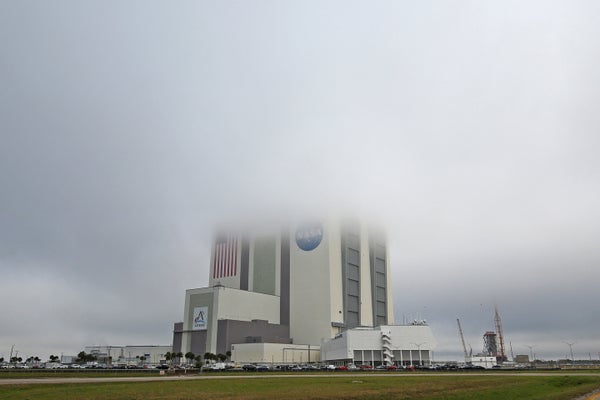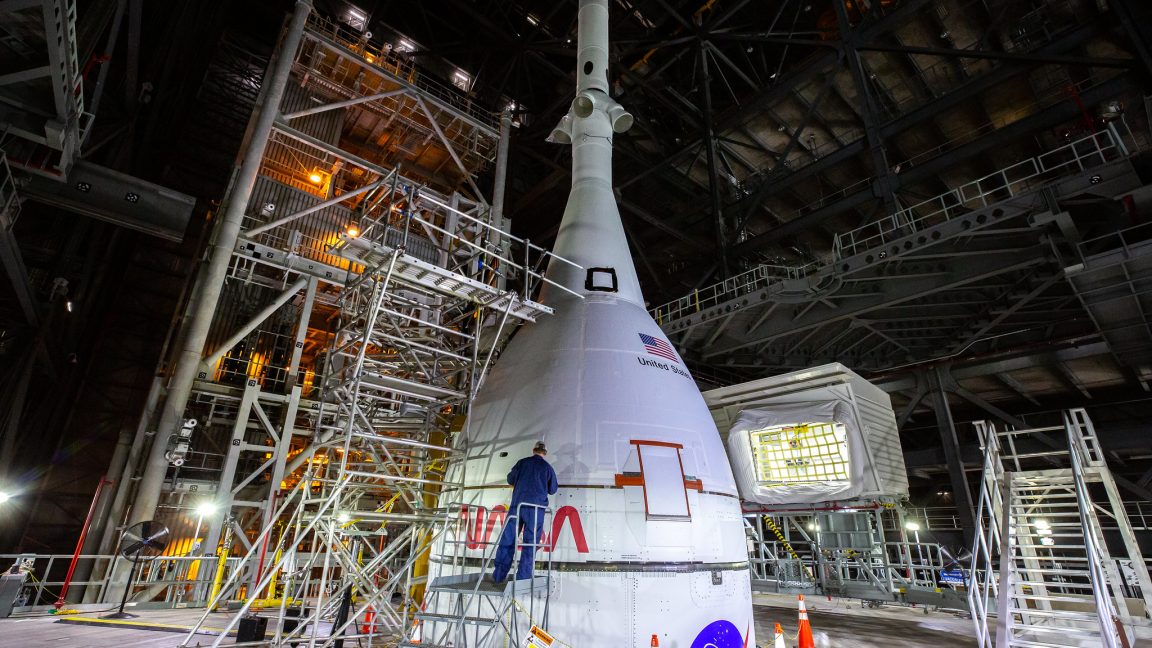The Trump-Musk Fight Could Have Huge Consequences for U.S. Space Programs
June 5, 20254 min readThe Trump-Musk Fight Could Have Huge Consequences for U.S. Space ProgramsA vitriolic war of words between President Donald Trump and SpaceX CEO Elon Musk could have profound repercussions for the nation’s civil and military space programsBy Lee Billings edited by Dean VisserElon Muskand President Donald Trumpseemed to be on good terms during a press briefing in the Oval Office at the White House on May 30, 2025, but the event proved to be the calm before a social media storm. Kevin Dietsch/Getty ImagesFor several hours yesterday, an explosively escalating social media confrontation between arguably the world’s richest man, Elon Musk, and the world’s most powerful, President Donald Trump, shook U.S. spaceflight to its core.The pair had been bosom-buddy allies ever since Musk’s fateful endorsement of Trump last July—an event that helped propel Trump to an electoral victory and his second presidential term. But on May 28 Musk announced his departure from his official role overseeing the U.S. DOGE Service. And on May 31 the White House announced that it was withdrawing Trump’s nomination of Musk’s close associate Jared Isaacman to lead NASA. Musk abruptly went on the attack against the Trump administration, criticizing the budget-busting One Big Beautiful Bill Act, now navigating through Congress, as “a disgusting abomination.”Things got worse from there as the blowup descended deeper into threats and insults. On June 5 Trump suggested on his own social-media platform, Truth Social, that he could terminate U.S. government contracts with Musk’s companies, such as SpaceX and Tesla. Less than an hour later, the conflict suddenly grew more personal, with Musk taking to X, the social media platform he owns, to accuse Trump—without evidence—of being incriminated by as-yet-unreleased government documents related to the illegal activities of convicted sex offender Jeffrey Epstein.On supporting science journalismIf you're enjoying this article, consider supporting our award-winning journalism by subscribing. By purchasing a subscription you are helping to ensure the future of impactful stories about the discoveries and ideas shaping our world today.Musk upped the ante further in follow-up posts in which he endorsed a suggestion for impeaching Trump and, separately, declared in a now deleted post that because of the president’s threat, SpaceX “will begin decommissioning its Dragon spacecraft immediately.”Dragon is a crucial workhorse of U.S. human spaceflight. It’s the main way NASA’s astronauts get to and from the International Space Stationand also a key component of a contract between NASA and SpaceX to safely deorbit the ISS in 2031. If Dragon were to be no longer be available, NASA would, in the near term, have to rely on either Russian Soyuz vehicles or on Boeing’s glitch-plagued Starliner spacecraft for its crew transport—and the space agency’s plans for deorbiting the ISS would essentially go back to the drawing board. More broadly, NASA uses SpaceX rockets to launch many of its science missions, and the company is contracted to ferry astronauts to and from the surface of the moon as part of the space agency’s Artemis III mission.Trump’s and Musk’s retaliatory tit for tat also raises the disconcerting possibility of disrupting other SpaceX-centric parts of U.S. space plans, many of which are seen as critical for national security. Thanks to its wildly successful reusable Falcon 9 and Falcon Heavy rockets, the company presently provides the vast majority of space launches for the Department of Defense. And SpaceX’s constellation of more than 7,000 Starlink communications satellites has become vitally important to war fighters in the ongoing conflict between Russia and U.S.-allied Ukraine. SpaceX is also contracted to build a massive constellation of spy satellites for the DOD and is considered a leading candidate for launching space-based interceptors envisioned as part of Trump’s “Golden Dome” missile-defense plan.Among the avalanche of reactions to the incendiary spectacle unfolding in real time, one of the most extreme was from Trump’s influential former adviser Steve Bannon, who called on the president to seize and nationalize SpaceX. And in an interview with the New York Times, Bannon, without evidence, accused Musk, a naturalized U.S. citizen, of being an “illegal alien” who “should be deported from the country immediately.”NASA, for its part, attempted to stay above the fray via a carefully worded late-afternoon statement from the space agency’s press secretary Bethany Stevens: “NASA will continue to execute upon the President’s vision for the future of space,” Stevens wrote. “We will continue to work with our industry partners to ensure the President’s objectives in space are met.”The response from the stock market was, in its own way, much less muted. SpaceX is not a publicly traded company. But Musk’s electric car company Tesla is. And it experienced a massive sell-off at the end of June 5’s trading day: Tesla’s share price fell down by 14 percent, losing the company a whopping billion of its market value.Today a rumored détente phone conversation between the two men has apparently been called off, and Trump has reportedly said he now intends to sell the Tesla he purchased in March in what was then a gesture of support for Musk. But there are some signs the rift may yet heal: Musk has yet to be deported; SpaceX has not been shut down; Tesla’s stock price is surging back from its momentary heavy losses; and it seems NASA astronauts won’t be stranded on Earth or on the ISS for the time being.Even so, the entire sordid episode—and the possibility of further messy clashes between Trump and Musk unfolding in public—highlights a fundamental vulnerability at the heart of the nation’s deep reliance on SpaceX for access to space. Outsourcing huge swaths of civil and military space programs to a disruptively innovative private company effectively controlled by a single individual certainly has its rewards—but no shortage of risks, too.
#trumpmusk #fight #could #have #huge
The Trump-Musk Fight Could Have Huge Consequences for U.S. Space Programs
June 5, 20254 min readThe Trump-Musk Fight Could Have Huge Consequences for U.S. Space ProgramsA vitriolic war of words between President Donald Trump and SpaceX CEO Elon Musk could have profound repercussions for the nation’s civil and military space programsBy Lee Billings edited by Dean VisserElon Muskand President Donald Trumpseemed to be on good terms during a press briefing in the Oval Office at the White House on May 30, 2025, but the event proved to be the calm before a social media storm. Kevin Dietsch/Getty ImagesFor several hours yesterday, an explosively escalating social media confrontation between arguably the world’s richest man, Elon Musk, and the world’s most powerful, President Donald Trump, shook U.S. spaceflight to its core.The pair had been bosom-buddy allies ever since Musk’s fateful endorsement of Trump last July—an event that helped propel Trump to an electoral victory and his second presidential term. But on May 28 Musk announced his departure from his official role overseeing the U.S. DOGE Service. And on May 31 the White House announced that it was withdrawing Trump’s nomination of Musk’s close associate Jared Isaacman to lead NASA. Musk abruptly went on the attack against the Trump administration, criticizing the budget-busting One Big Beautiful Bill Act, now navigating through Congress, as “a disgusting abomination.”Things got worse from there as the blowup descended deeper into threats and insults. On June 5 Trump suggested on his own social-media platform, Truth Social, that he could terminate U.S. government contracts with Musk’s companies, such as SpaceX and Tesla. Less than an hour later, the conflict suddenly grew more personal, with Musk taking to X, the social media platform he owns, to accuse Trump—without evidence—of being incriminated by as-yet-unreleased government documents related to the illegal activities of convicted sex offender Jeffrey Epstein.On supporting science journalismIf you're enjoying this article, consider supporting our award-winning journalism by subscribing. By purchasing a subscription you are helping to ensure the future of impactful stories about the discoveries and ideas shaping our world today.Musk upped the ante further in follow-up posts in which he endorsed a suggestion for impeaching Trump and, separately, declared in a now deleted post that because of the president’s threat, SpaceX “will begin decommissioning its Dragon spacecraft immediately.”Dragon is a crucial workhorse of U.S. human spaceflight. It’s the main way NASA’s astronauts get to and from the International Space Stationand also a key component of a contract between NASA and SpaceX to safely deorbit the ISS in 2031. If Dragon were to be no longer be available, NASA would, in the near term, have to rely on either Russian Soyuz vehicles or on Boeing’s glitch-plagued Starliner spacecraft for its crew transport—and the space agency’s plans for deorbiting the ISS would essentially go back to the drawing board. More broadly, NASA uses SpaceX rockets to launch many of its science missions, and the company is contracted to ferry astronauts to and from the surface of the moon as part of the space agency’s Artemis III mission.Trump’s and Musk’s retaliatory tit for tat also raises the disconcerting possibility of disrupting other SpaceX-centric parts of U.S. space plans, many of which are seen as critical for national security. Thanks to its wildly successful reusable Falcon 9 and Falcon Heavy rockets, the company presently provides the vast majority of space launches for the Department of Defense. And SpaceX’s constellation of more than 7,000 Starlink communications satellites has become vitally important to war fighters in the ongoing conflict between Russia and U.S.-allied Ukraine. SpaceX is also contracted to build a massive constellation of spy satellites for the DOD and is considered a leading candidate for launching space-based interceptors envisioned as part of Trump’s “Golden Dome” missile-defense plan.Among the avalanche of reactions to the incendiary spectacle unfolding in real time, one of the most extreme was from Trump’s influential former adviser Steve Bannon, who called on the president to seize and nationalize SpaceX. And in an interview with the New York Times, Bannon, without evidence, accused Musk, a naturalized U.S. citizen, of being an “illegal alien” who “should be deported from the country immediately.”NASA, for its part, attempted to stay above the fray via a carefully worded late-afternoon statement from the space agency’s press secretary Bethany Stevens: “NASA will continue to execute upon the President’s vision for the future of space,” Stevens wrote. “We will continue to work with our industry partners to ensure the President’s objectives in space are met.”The response from the stock market was, in its own way, much less muted. SpaceX is not a publicly traded company. But Musk’s electric car company Tesla is. And it experienced a massive sell-off at the end of June 5’s trading day: Tesla’s share price fell down by 14 percent, losing the company a whopping billion of its market value.Today a rumored détente phone conversation between the two men has apparently been called off, and Trump has reportedly said he now intends to sell the Tesla he purchased in March in what was then a gesture of support for Musk. But there are some signs the rift may yet heal: Musk has yet to be deported; SpaceX has not been shut down; Tesla’s stock price is surging back from its momentary heavy losses; and it seems NASA astronauts won’t be stranded on Earth or on the ISS for the time being.Even so, the entire sordid episode—and the possibility of further messy clashes between Trump and Musk unfolding in public—highlights a fundamental vulnerability at the heart of the nation’s deep reliance on SpaceX for access to space. Outsourcing huge swaths of civil and military space programs to a disruptively innovative private company effectively controlled by a single individual certainly has its rewards—but no shortage of risks, too.
#trumpmusk #fight #could #have #huge














